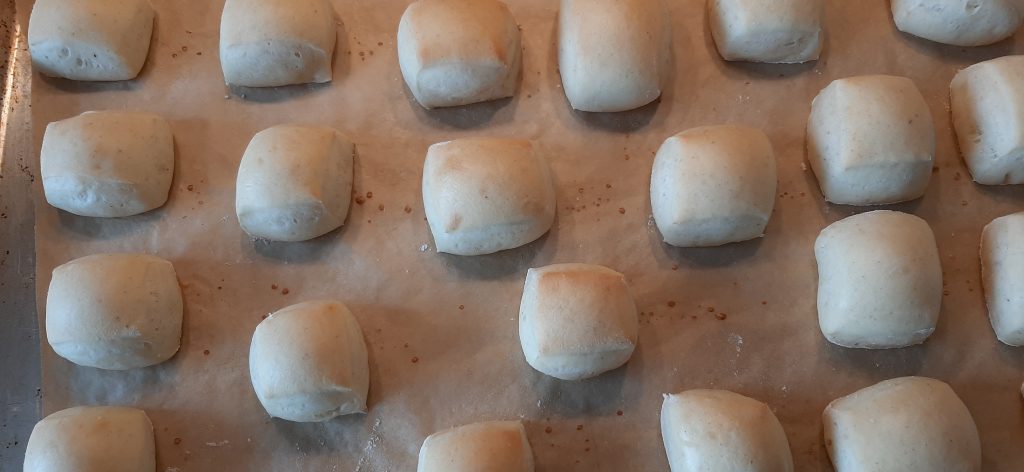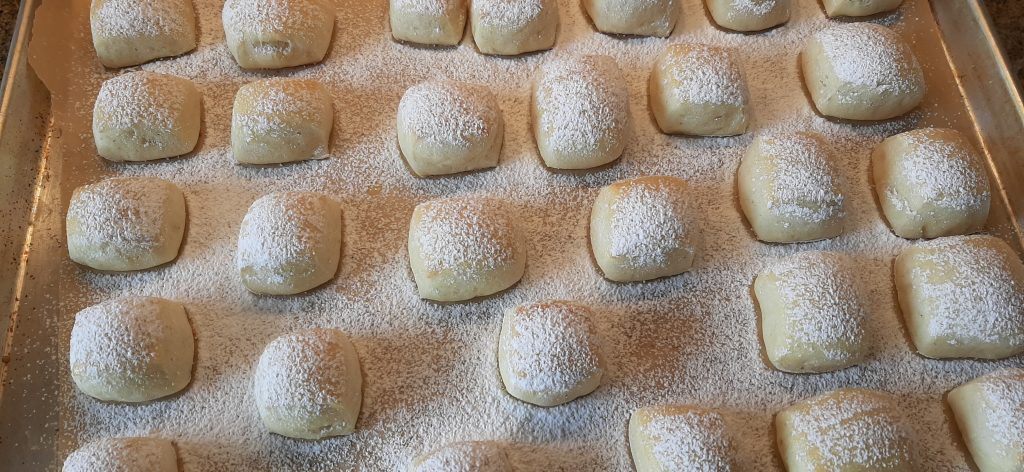

Top picture, beignets just out of the oven. Second picture, after sprinkled with powdered sugar.
Just so you know, New Orleans style beignets are different from classic French beignets in that the dough for New Orleans beignets includes yeast to help the dough rise. True French beignets are a choux pastry (no yeast) that relies on moisture content instead of yeast to facilitate rising. (And yes, Café du Monde uses yeast in their beignet dough. And of course, they deep fat fry their beignets, and serve them hot out of their oil bath liberally sprinkled with powdered sugar. But we aren’t going in that direction today. Except for the powdered sugar sprinkling. We are all in on that part!)
Now, if you are not familiar with beignets, allow me to elucidate. Beignets are a type of donut, but with a bit more of a yeast risen texture. And the flavor on the inside is not as sweet as a traditional donut. Which I especially appreciate. But for some, beignets are not as sweet and therefore not as well-known or well-loved as glazed or frosted donuts.
So, in order to make everyone happy, I have given you the recipe for baked beignets topped with powdered sugar. But for those of you who prefer a sweeter overall flavor, I have provided 3 topping recipes to sweeten these basic donuts up a bit. So, below you will find my recipes for Vanilla Glaze, Spiced Rum Glaze, and my crazy good Maple Frosting. If choosing one of these options or your own favorite topping, no need to brush with melted butter and sprinkle with powdered sugar. Just let the baked squares (or your choice of shape) cool completely before adding the glaze or frosting.
The difference with this recipe from other recipes for beignets is not the ingredients in the dough, but the method of turning them from dough into an edible product. In this happy journey to beignet/donut paradise, there is no hot oil used in the making of these tasty morsels. Your oven fulfills that responsibility. Plus, you can choose to make the dough the day before or the same day. Whichever method works best for you. And wait until you read how easy the dough is to prepare. You are going to be blown away. (Hopefully towards your kitchen.) Because this simple recipe makes for some extremely delicious treats that everyone you serve them to is going to love.
One thing I should mention however, which is true for either baked or fried beignets or donuts; they are at their best the day they are made. So, plan to serve them the same day or if that isn’t possible, gently warm them the next day. But be prepared to re-sprinkle them with more powdered sugar. (Like that’s a bad thing. Not!)
So, without further ado (drum roll please), welcome to the world of baked beignets. Or baked glazed or frosted donuts. Regardless of which way you go, you are in for a new and (slightly) healthier way to enjoy a donut.
As always, peace and love to all.
¾ c. lukewarm water
¼ c. granulated sugar
1½ tsp. active dry or instant yeast
1 lg. egg
½ c. buttermilk
4 T. (½ stick) unsalted butter, melted, divided
½ tsp. kosher salt
2 tsp. vanilla bean paste or vanilla extract
3½ to 3¾ c. unbleached all-purpose flour, fluffed, or a tiny bit more as needed
veggie oil (for greasing the mixing bowl)
1 T. milk
powdered sugar (for dusting)
In the bowl of your stand mixer, combine the water, sugar, and yeast with your dough hook and stir until well combined. Let sit for about 10 minutes or until the yeast starts to get foamy on the surface.
Add the egg, buttermilk, 3 tablespoons of the melted butter, salt, and vanilla; mix to combine. Add 3½ cups of fluffed flour and stir on medium-low speed until the dough comes together. The dough should be slightly sticky to touch, but a bit of the dough should still be sticking to the bottom of the bowl. (Resist the urge to add too much flour.) Then turn on medium speed and knead for about 5 minutes.
Pour a small amount of oil into the mixing bowl, and using your hands and a stiff rubber spatula, form the dough into a ball lightly coated with the oil. Cover with plastic wrap.
To bake beignets the same day:
Let the dough rise until doubled in size. (About 2 hours.)
Roll dough to ¼-inch thickness and cut into 1½-2-inch squares. (This is easy to do with a pizza cutter.)
Place the squares on baking sheets lined with parchment paper 1-inch apart. Let the dough rise for about 60 minutes or until the dough is puffy and about doubled in size.
Brush each square lightly with milk and bake in a pre-heated 350-degree oven for about 15 minutes, or until very lightly browned. Don’t overbake.
Remove from oven and while the beignets are still warm (after about 5 minutes), brush them with remaining melted butter and generously dust* with powdered sugar. If possible, eat while still warm.
To bake beignets the next day: Place the covered mixing bowl in the refrigerator overnight. The dough will double or triple in size while it’s in the fridge. Remove from the fridge at least 45 minutes before you plan to roll out and cut the dough.
On a lightly floured surface, roll the dough to ¼-inch thickness and cut into 1½-2-inch squares. (This is easy to do with a pizza cutter.)
Place on parchment paper lined baking sheets at least 1-inch apart. Let the dough rise for about 60 minutes or until the dough is puffy and about doubled in size.
Brush each square lightly with milk and bake in a pre-heated 350-degree oven for about 15 minutes, or until slightly browned. Don’t overbake.
Remove from oven and while the beignets are still warm (after about 5 minutes), brush them with remaining melted butter and generously dust* with powdered sugar. Eat while still warm.
Please note: If you don’t plan to eat all the beignets in one sitting, warm them in your microwave for about 10 seconds just before serving. Then sprinkle with more powdered sugar if necessary.
*An easy way to sprinkle/dust powdered sugar is to place a small amount in a fine mesh strainer and then shake the strainer over whatever you wish to decorate. This same technique works well with cocoa for chocolate dusting.
VANILLA GLAZE
2 c. powdered sugar
⅛ teaspoon salt
1 tsp. vanilla bean paste or vanilla extract
5-6 T. whole milk or cream
Whisk all the ingredients together in a medium bowl until smooth.
Place the beignets on a wire rack over a baking sheet. Coat the beignets with the glaze by dunking each one into the glaze. Place back on the wire, glazed side up, to set completely before storing in an airtight container.
SPICED RUM GLAZE
1 c. powdered sugar
1 tsp. rum
tiny pinch cinnamon
tiny pinch nutmeg
2–3 T. whole milk
In a small bowl, whisk the powdered sugar, rum, cinnamon, nutmeg, and 2 tablespoons milk together. If needed, add more milk to achieve desired consistency.
Place completely cooled beignet pieces on a large baking sheet. Drizzle on the glaze. Allow glaze to harden before storing in an airtight container.
MAPLE FROSTING
2 T. unsalted butter
¼ c. brown sugar, packed
2 T. whole milk
1½ tsp. corn syrup
1 tsp. good maple extract
1 c. powdered sugar
In a small saucepan, melt the butter, then whisk in the brown sugar. When the brown sugar starts to dissolve whisk in the milk and simmer for about 3 minutes over medium heat, stirring continuously until the brown sugar is completely dissolved.
Remove from heat and whisk in the corn syrup and maple extract. Then whisk in the powdered sugar until the frosting is smooth and free of powdered sugar lumps.
Using a large spoon, ladle frosting onto each cooled beignet piece.
Warning: Work quickly or the frosting will start to set up before you get to the last piece. (Take my word for this!)
